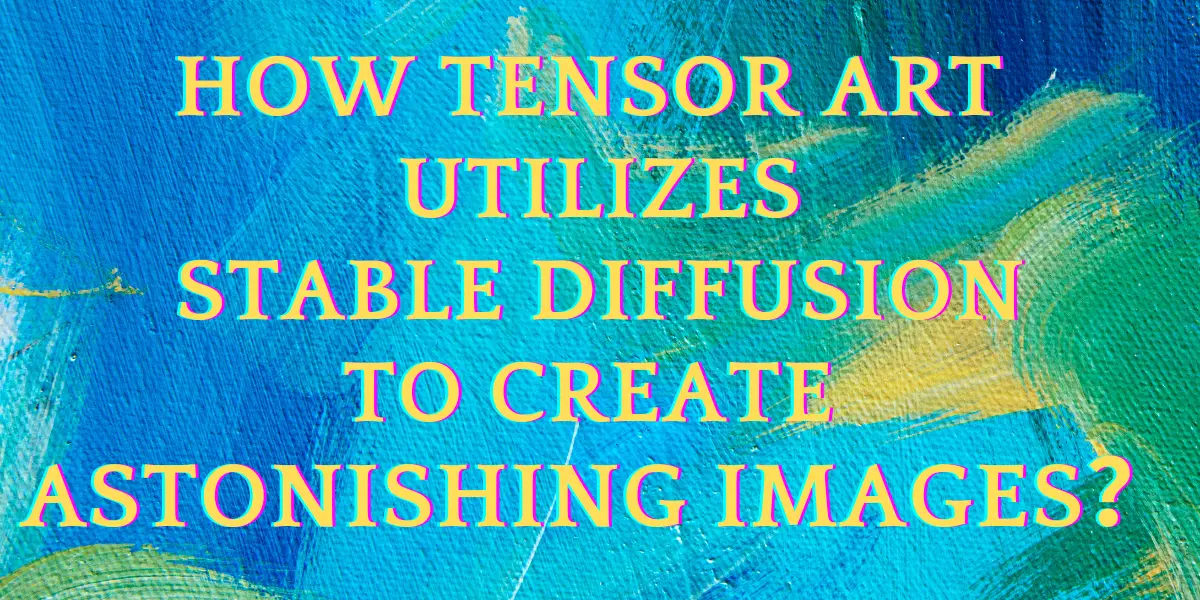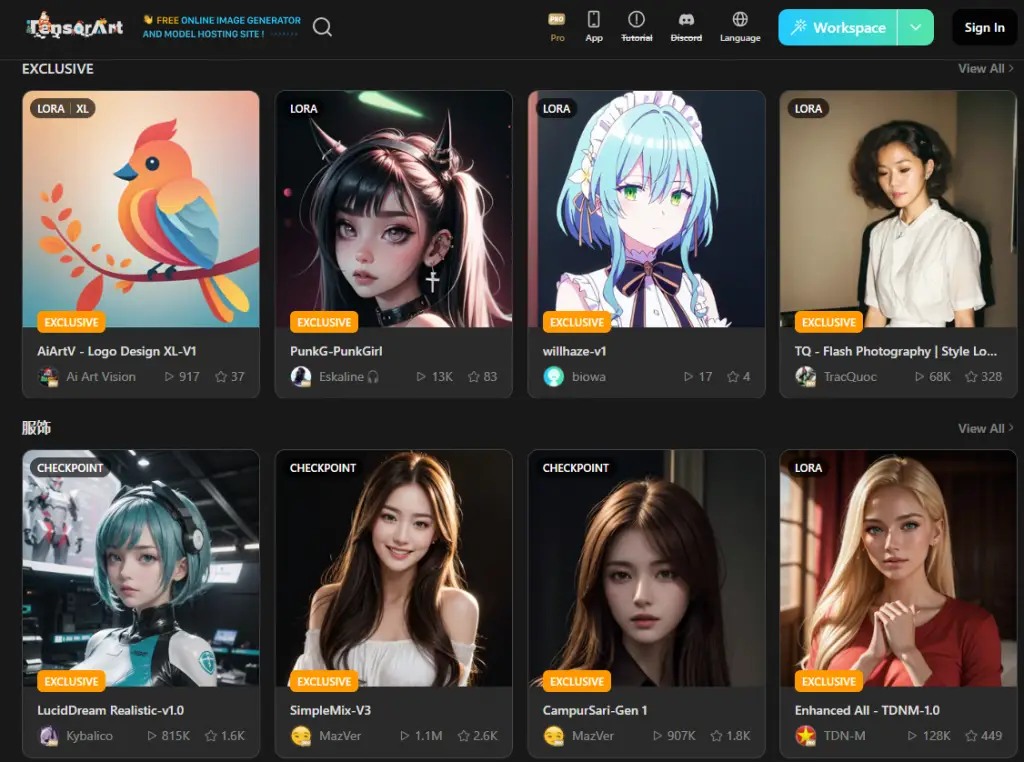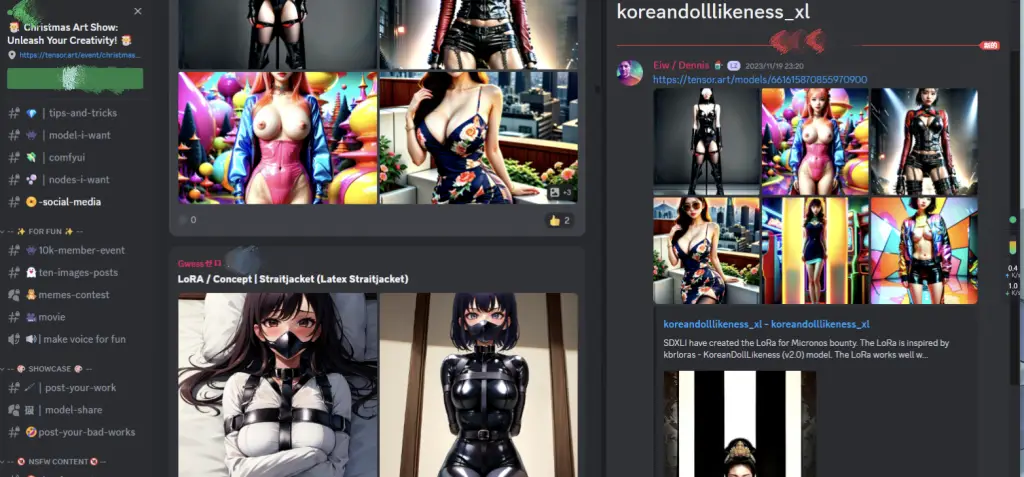How Tensor Art Utilizes Stable Diffusion to Create Astonishing Images?

Welcome to the world of Tensor Art, a cutting-edge platform where the realms of artificial intelligence and artistic creativity converge. As a remarkable AI tools, Tensor Art harnesses the power of Stable Diffusion technology to transform text prompts, sketches, and photos into stunning digital artworks. This platform stands out for its user-friendly interface, making it accessible to both seasoned artists and those new to digital art. With a diverse range of models catering to various artistic styles – from realistic landscapes and abstract concepts to detailed character portraits and fantasy themes – Tensor Art offers an expansive canvas for creative expression. Beyond artistic exploration, it also presents monetization opportunities, allowing artists to earn from their AI-generated creations.
Tensor Art revolutionizes digital art creation by combining AI technology with user creativity, offering diverse models and monetization opportunities.
Table of Contents
What is Tensor Art?
Tensor Art is a web-based platform that leverages advanced artificial intelligence models to create artistic images from text or other inputs. Utilizing the power of Stable Diffusion, a technique that enhances the process of image generation and manipulation, Tensor Art enables users to transform simple text descriptions, sketches, or photos into stunning digital artwork. The platform is designed to be user-friendly, catering to both experienced artists and those new to AI art creation.At the same time, Tensor Art is also a nsfw ai art generator with ai nude generator properties. It offers a range of models for various artistic styles and preferences, including the ability to generate adult-oriented content under specific guidelines.
How Tensor Art Uses Stable Diffusion?
Step 1: Initiating Image Creation with Text Prompts
The journey into AI-generated art with Tensor Art begins with a simple yet powerful tool: text prompts. Users start by entering descriptive phrases or sentences into Tensor Art’s interface. These prompts can range from vivid descriptions of landscapes to abstract concepts or character ideas. The more detailed the prompt, the more guidance the AI has to visualize the concept. This initial step is crucial as it sets the direction for the AI model, leveraging the user’s creativity as the foundation for the artwork.
Step 2: Transforming Text into Realistic Images with Stable Diffusion
Once the text prompt is set, Stable Diffusion comes into play. This advanced AI model interprets the text input and begins the process of image generation. Stable Diffusion is designed to understand and translate the nuances of the text into visual elements, creating images that align closely with the user’s vision. The model’s ability to convert textual descriptions into high-quality, realistic images is what makes Tensor Art a groundbreaking tool for artists and enthusiasts alike.
Step 3: The Role of Diffusion Processes in Image Generation
Stable Diffusion utilizes a unique approach known as diffusion processes. This technique involves gradually adding noise to an initial image, effectively randomizing it, and then meticulously reversing the process. During the reversal, the AI model refines the image, step by step, removing the noise and shaping the final image based on the initial text prompt. This method ensures a blend of creativity and precision, allowing for the generation of complex and detailed images.
Step 4: Maintaining Image Quality through Noise Regulation
A critical aspect of Stable Diffusion’s process is the regulation of noise. Controlling the noise levels during the diffusion process is essential for maintaining the quality, consistency, and coherence of the generated images. This balance is what allows Tensor Art to produce visually appealing artwork that remains true to the user’s original concept. The noise regulation not only enhances the aesthetic appeal of the images but also ensures that they are clear, coherent, and true to the intended style.
Step 5: Generating Images from Sketches or Photos
Beyond text prompts, Stable Diffusion in Tensor Art also has the capability to generate images based on sketches or photos. Users can upload their drawings or photographs, and the AI model will use them as a base to create new artwork. This feature opens up a realm of possibilities, allowing users to transform their sketches into detailed artworks or modify existing photos into new artistic interpretations. The ability to work with visual inputs adds another layer of flexibility and creativity to Tensor Art, making it a versatile tool for various artistic endeavors.

Features and Benefits of Tensor Art
User-Friendly Interface
- Intuitive Design: Tensor Art’s platform is designed with clarity and simplicity, making it easy for users to navigate and utilize various tools.
- Guided Process: The platform provides helpful guides and tips, especially beneficial for new users, ensuring a smooth introduction to AI art generation.
- Customizable Settings: Users have the flexibility to adjust various settings, allowing them to tailor the image generation process to their specific artistic preferences.
Diverse Range of Models
- Variety of Styles: Tensor Art offers a wide array of models, catering to different artistic styles from realistic landscapes to abstract art.
- Specialized Models: For genres like anime or fantasy, the platform provides specialized models to align with these specific themes.
- Inclusive Options: Including models for adult-oriented content, Tensor Art offers a broad spectrum of artistic expressions to cater to diverse user preferences.
Advanced AI Technology
- Stable Diffusion: The platform utilizes Stable Diffusion technology to transform text descriptions into visually stunning artworks with remarkable accuracy.
- Image-to-Image Generation: Beyond text prompts, Tensor Art can generate images based on existing sketches or photos, adding another layer of creativity.
- Fine-Tuning Capabilities: Users can fine-tune their creations, making detailed adjustments to achieve the desired balance and style in their artwork.
Monetization Opportunities
- Earning Through Models: Artists have the opportunity to create and share models on the platform, potentially earning revenue through their popularity and usage.
- Building a Following: By showcasing their work, artists can build a following, enhancing their visibility and potential for monetization.
- Community Engagement: The platform fosters community interaction, encouraging artists to connect, collaborate, and explore new creative opportunities.
Ethical and Responsible Use
- Content Guidelines: Tensor Art maintains clear guidelines on content creation, especially regarding adult-oriented images, ensuring responsible use of the platform.
- User Control: The platform empowers users with control over their content, promoting a sense of responsibility and respect within the community.
- Focus on Creativity: Emphasizing the creative aspect of AI art generation, Tensor Art encourages users to responsibly explore and express their artistic visions.
How to Sign up Tensor Art?
Step 1: Visit the Official Website
To begin your journey with Tensor Art, start by visiting their official website. The website is designed to be welcoming and informative, providing you with an overview of what Tensor Art offers. On the homepage, you’ll find the “Sign In” option prominently displayed. This is your gateway to accessing the platform’s vast array of features and tools for AI art creation.
Step 2: Choose Your Sign-In Method
Tensor Art provides various sign-in options for easy access. You can choose to sign in using your Google or Discord account, among other options. This flexibility ensures that you can quickly and securely access the platform using your preferred method. The sign-in process is streamlined to ensure that you can get started with creating your AI art as soon as possible.
Step 3: Explore the Platform
Once signed in, take some time to explore the platform. Familiarize yourself with the layout, the available tools, and the range of models that Tensor Art offers. This exploration will help you understand the capabilities of the platform and how you can leverage them to create stunning AI-generated ar

How to Use Tensor Art?
Step 1: Select a Model
The first step in using Tensor Art is selecting a model that aligns with your creative vision. Tensor Art offers a variety of models, each capable of generating different styles of art. Whether you are interested in creating realistic images, abstract art, or something in between, there is a model for you. Choose the one that best fits the type of artwork you want to create.
Step 2: Enter Your Creative Prompt
After selecting a model, you will be prompted to enter a creative text description. This is where you can let your imagination run wild. Describe in detail what you want your artwork to look like. The more descriptive and vivid your prompt, the better the AI can understand and visualize your concept.
Step 3: Adjust the Settings
Tensor Art provides a range of settings that you can adjust to influence the final outcome of your artwork. These settings are instrumental in shaping how your art will look. Experiment with different settings to see how they affect the image generation process. This step is crucial in customizing the artwork to your liking.
Step 4: Generate Your Artwork
Once you are satisfied with your prompt and settings, the final step is to click on “Generate.” This action triggers the AI to start creating your artwork based on the parameters you’ve set. The process is a blend of AI technology and your creative input, resulting in a unique piece of art that reflects your vision.
What models are available on Tensor Art?
Realistic Landscape Models
Tensor Art offers models specifically designed for creating realistic landscapes. These models are adept at generating images that capture the essence of natural scenery, from serene beaches to majestic mountains.
- High Detail Rendering: The landscape models are capable of rendering high levels of detail, making each element of the scene – like trees, water, and skies – appear lifelike.
- Adaptability to Prompts: These models are highly responsive to user prompts, accurately interpreting descriptions to create landscapes that closely match the envisioned scenery.
- Versatility in Styles: Whether you’re looking for a sunlit meadow or a moonlit seascape, these models can cater to a wide range of natural settings.
Abstract Concept Models
For those who prefer a more imaginative and less literal approach to art, Tensor Art provides models that excel in generating abstract concepts. These models are ideal for visualizing ideas that are more about conveying emotions or abstract themes.
- Creative Freedom: These models offer a high degree of creative freedom, allowing users to explore abstract ideas without the constraints of realistic representation.
- Color and Form Exploration: They excel in playing with colors and forms, creating images that can be interpretative and emotionally evocative.
- Ideal for Conceptual Art: Artists looking to create pieces that provoke thought or convey complex ideas will find these models particularly useful.
Character and Portrait Models
Tensor Art includes models specifically tailored for creating character portraits. These models are perfect for artists who want to bring fictional characters to life or reimagine real people in unique ways.
- Facial Detail Accuracy: These models are skilled at capturing facial details, making them ideal for creating portraits with expressive and nuanced features.
- Customization for Characters: They offer extensive customization options, allowing users to specify characteristics like age, emotion, and style.
- Diverse Representation: The models can generate a wide range of character types, ensuring diversity and inclusivity in the portrayal of characters.
Anime and Fantasy Models
For fans of anime and fantasy genres, Tensor Art provides specialized models that cater to these specific artistic styles.
- Genre-Specific Features: These models are trained to understand and replicate the unique features of anime and fantasy art, such as exaggerated expressions and fantastical elements.
- Stylized Art Creation: They are adept at creating art that adheres to the stylistic norms of anime and fantasy, ensuring authenticity in the artwork.
- Engaging for Fans: These models are particularly engaging for fans of the genres, offering them a tool to create art that resonates with their interests and passions.

Can I earn money on Tensor Art?
Yes, Tensor Art offers opportunities for users to monetize their creations. Artists and creators can earn money through the platform by generating unique models and building a following. By sharing their models and artwork, users can attract a community of followers and enthusiasts, potentially leading to revenue generation. This monetization aspect is particularly appealing to digital artists and AI art enthusiasts who are looking to capitalize on their creative skills. The platform provides a space not only for artistic expression but also for entrepreneurial ventures within the realm of AI-generated art.
Can I create adult-oriented images on Tensor Art?
Tensor Art does allow the creation of adult-oriented images, but it operates within a framework of ethical guidelines and content policies. The platform includes models that are intended for mature audiences, catering to a diverse range of artistic expressions, including adult-themed art. However, users are expected to adhere to the platform’s guidelines and respect community standards when creating and sharing such content. This approach ensures that while creative freedom is upheld, it is balanced with a sense of responsibility and respect for the community and the ethical use of AI in art.
Conclusion
Tensor Art represents a significant advancement in the realm of digital art, seamlessly blending the power of AI with human creativity. Through its user-friendly interface, diverse range of models, and advanced Stable Diffusion technology, Tensor Art opens up new horizons for artists and enthusiasts alike. Whether it’s creating realistic landscapes, abstract concepts, detailed character portraits, or exploring the realms of anime and fantasy, the platform caters to a wide spectrum of artistic preferences. Additionally, its monetization opportunities and inclusive options for adult-oriented content demonstrate its versatility and appeal to a broad audience. Tensor Art stands as a testament to the innovative possibilities that AI brings to the art world, offering a unique space for creative expression, exploration, and even financial gain.

